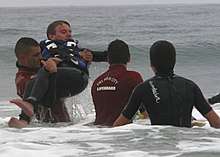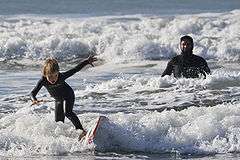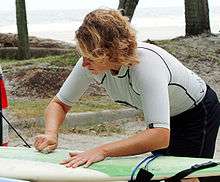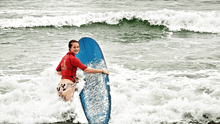Glossary of surfing
This glossary of surfing includes some of the extensive vocabulary used to describe various aspects of the sport of surfing as described in literature on the subject.[a][b] In some cases terms have spread to a wider cultural use. These terms were originally coined by people who were directly involved in the sport of surfing.
.jpg)
NSSA Championships, Huntington Beach Pier
About the water

Breaking swell waves at Hermosa Beach, California
- Barrel: (also Tube, Cave, Keg, Green Room) The effect when a big wave rolls over, enclosing a temporary horizontal tunnel of air with the surfer inside[c]
- Beach break: An area where waves that are good enough to surf break just off a beach, or on a sandbar farther out[c]
- Blown out: When waves that would otherwise be good have been rendered too choppy by wind[c]
- Bomb: An exceptionally large set wave[d]
- Chop or choppy: Waves that are subjected to cross winds have a rough surface (chop) and do not break cleanly [d]
- Close-out: A wave is said to be "closed-out" when it breaks at every position along the face at once, and therefore cannot be surfed
- Face: The forward-facing surface of a breaking wave [c]
- Flat: No waves[c]
- Glassy: When the waves (and general surface of the water) are extremely smooth and glossy, not disturbed by wind [c]
- Gnarly: Large, difficult, and dangerous (usually applied to waves) [c]
- Line-up: The queue area where most of the waves are starting to break and where most surfers are positioned in order to catch a wave[a]
- Off the hook: An adjective phrase meaning the waves are performing extraordinarily well. [c]
- Outside: The part of the water's surface that is farther from the shore than the area where most waves are breaking
- Point break: Area where an underwater rocky point creates waves that are suitable for surfing [c]
- Sections: The parts of a breaking wave that are rideable[c]
- Set waves: A group of waves of larger size within a swell[c]
- Shoulder: The unbroken part of the breaking wave[c]
- Surf's up: A phrase used when there are waves worth surfing
- Swell: A series of waves that have traveled from their source in a distant storm, and that will start to break once the swell reaches shallow enough water
- Whitewater: In a breaking wave, it continues on as a ridge of turbulence and foam called "whitewater"[d]
Techniques and maneuvers
- Air/Aerial: Riding the board briefly into the air above the wave, landing back upon the wave, and continuing to ride[d]
- Bail: To step off the board in order to avoid being knocked off (a wipe out)[d]
- Bottom turn: The first turn at the bottom of the wave[d]
- Carve: Turns (often accentuated)
- Caught inside: When a surfer is paddling out and cannot get past the breaking surf to the safer part of the ocean (the outside) in order to find a wave to ride[d]
- Cheater five: See Hang-five/hang ten
- Cross-step: Crossing one foot over the other to walk down the board
- Cutback: A turn cutting back toward the breaking part of the wave
- Drop in: Dropping into (engaging) the wave, most often as part of standing up[d]
- "To drop in on someone": To take off on a wave that is already being ridden. Not a legitimate technique or maneuver. It is a serious breach of surfing etiquette.[1]
- Duck dive: Pushing the board underwater, nose first, and diving under an oncoming wave instead of riding it[d]
- Fade: On take-off, aiming toward the breaking part of the wave, before turning sharply and surfing in the direction the wave is breaking
- Fins-free snap (or "fins out"): A sharp turn where the surfboard's fins slide off the top of the wave[f]
- Floater: Riding up on the top of the breaking part of the wave, and coming down with it[c]
- Goofy foot: Surfing with the left foot on the back of board (less common than regular foot)[d]
- Hang Heels: Facing backwards and putting the surfers' heels out over the edge of a longboard
- Hang-five/hang ten: Putting five or ten toes respectively over the nose of a longboard
- Nose ride, the art of maneuvering a surfboard from the front end
- Off the Top: A turn on the top of a wave, either sharp or carving
- Pop-up: Going from lying on the board to standing, all in one jump[d]
- Pump: An up/down carving movement that generates speed along a wave[d]
- Re-entry: Hitting the lip vertically and re-reentering the wave in quick succession.[d]
- Regular/Natural foot: Surfing with the right foot on the back of the board[d]
- Rolling, Turtle Roll: Flipping a longboard up-side-down, nose first and pulling through a breaking or broken wave when paddling out to the line-up (a turtle roll is an alternative to a duck dive)[d]
- Smack the Lip / Hit the Lip: After performing a bottom turn, moving upwards to hit the peak of the wave, or area above the face of the wave.[2]
- Snaking, drop in on, cut off, or "burn": When a surfer who doesn't have the right of way steals a wave from another surfer by taking off in front of someone who is closer to the peak (this is considered inappropriate)[d]
- Snaking/Back-Paddling: Stealing a wave from another surfer by paddling around the person's back to get into the best position[d]
- Snap: A quick, sharp turn off the top of a wave
- Soul arch: Arching the back to demonstrate casual confidence when riding a wave
- Stall: Slowing down by shifting weight to the tail of the board or putting a hand in the water. Often used to stay in the tube during a tube ride[c]
- Side-slip: travelling down a wave sideways to the direction of the board[3]
- Switchfoot: Ambidextrous, having equal ability to surf regular foot or goofy foot (i.e. left foot forward or right foot forward)
- Take-off: The start of a ride[4]
- Tandem surfing: Two people riding one board. Usually the smaller person is balanced above (often held up above) the other person[f]
- Tube riding/Getting barreled: Riding inside the hollow curl of a wave
Accidental

Wipeout
- Over the falls: When a surfer falls off the board and the wave sucks them up in a circular motion along with the lip of the wave. Also referred to as the "wash cycle", being "pitched over" and being "sucked over"[e]
- Wipe out: Falling off, or being knocked off, the surfboard when riding a wave[e]
- Rag dolled: When underwater, the power of the wave can shake the surfer around as if they were a rag doll[5]
- Tombstone: When a surfer is held underwater and tries to climb up their leash the board is straight up and down[e]
- Pearl: Accidentally driving the nose of the board underwater, generally ending the ride[d]
About people

Young grommet on a board with his dad watching.
- Dilla: A surfer who is low maintenance, without concern, worry or fuss, One who is confidently secure in being different or unique[6]
- Grom/Grommet: A young surfer[a]
- Hang loose: Generally means "chill", "relax" or "be laid back". This message can be sent by raising a hand with the thumb and pinkie fingers up while the index, middle and ring fingers remain folded over the palm, then twisting the wrist back and forth as if waving goodbye, see shaka sign
- Hodad: A nonsurfer who pretends to surf and frequents beaches with good surfing[7]
- Kook: A wanna-be surfer of limited skill[8][9]
- Waxhead: Someone who surfs every day[e]
About the board

Waxing a surfboard
- Blank: The block from which a surfboard is created
- Deck: The upper surface of the board
- Ding: A dent or hole in the surface of the board resulting from accidental damage[a]
- Fin or Fins: Fin-shaped inserts on the underside of the back of the board that enable the board to be steered
- Leash: A cord that is attached to the back of the board, the other end of which wraps around the surfer's ankle
- Nose : The forward tip of the board
- Quiver: A surfer's collection of boards for different kinds of waves[10]
- Rails: The side edges of the surfboard
- Rocker: How concave the surface of the board is from nose to tail
- Stringer: The line of wood that runs down the center of a board to hold its rigidity and add strength
- Tail: The back end of the board
- Wax: Specially formulated surf wax that is applied to upper surface of the board to increase the friction so the surfer's feet do not slip off the board
Clothing

A woman wearing a rash guard while surfing
- Board shorts; also known as Baggies.
- Pendleton jacket; popularized by the Beach Boys.
- Rash guard
- Wetsuit: Often referred to as "rubber", sometimes surfers also wear a neoprene hood and booties in cold conditions
Further reading
- Finney, Ben; Houston, James D. (1996). "Appendix A-Hawaiian Surfing terms". Surfing-A History of the Ancient Hawaiian Sport. Rohnett, CA: Pomegranate Artbooks. pp. 94–97. ISBN 0-87654-594-0.
gollark: ·
gollark: Are there goblins *following* us, or did we accidentally borrow one?
gollark: Oh dear.
gollark: We should probably flee.
gollark: uqb, please drive us away now.
See also
Notes
- Miller, Scott D.; Mark Hubble; Seth Houdeshell (2003). "Glossary of surfing terms". Staying on Top and Keeping the Sand Out of Your Pants: A Surfer's Guide to the good life. Deerfield Beach, FL: Heath Communications. pp. 139–140. ISBN 0-7573-0033-2.
- Guisado, Raul (2003). "Appendix A-Glossary of Surfing Lingo". The Art of Surfing: A Training Manual for the Developing and Competitive Surfer. Guilford, CT: Globe Pequot Press. pp. 165–0170. ISBN 0-7627-2466-8.
- "List of slang and technical terms". Surf lounge. 16 November 2015. Retrieved 17 November 2015.
- "Surf Terms, Slang and Phrases". Surfing Waves. Retrieved 6 October 2003.
- "SURFER SLANG 101". STOKED SURF SCHOOL. Retrieved 9 January 2020.
- "Surf Slang". Cougartown. Retrieved 17 January 2019.
- "The complete list of surfing tricks and maneuvers". Surfer Today. Retrieved 10 January 2020.
References
- "How to Not Be A Dickhead in The Water - Surfing Rules". Planet Surfcamps. 14 March 2018.
- "Surf Terminology: What it Means to Smack the Lip".
- "Corky Carroll: 'Side-slipping' may be a lost surf skill, but it still has a purpose". 22 October 2019.
- "Mastering the Take Off". Magicseaweed.com.
- "Catch the wave! Huge crash sees surfer get tossed about like a rag doll". 13 June 2018.
- "So...Whats a Dilla?".
- "Hodad". Merriam-Webster. Encyclopædia Britannica. Retrieved 10 April 2015.
- "What's a Kook? | Surf Slang". 21 October 2016.
- SurferToday.com, Editor at. "How to spot a kook in surfing". Surfertoday.CS1 maint: extra text: authors list (link)
- Surfboards, Degree 33. "How to Build Your Surfboard Quiver". Degree 33 Surfboards.
External links
| Look up Appendix:Glossary of surfing terms in Wiktionary, the free dictionary. |
- "Surf Slang". Cougartown. Retrieved 17 January 2019.
This article is issued from Wikipedia. The text is licensed under Creative Commons - Attribution - Sharealike. Additional terms may apply for the media files.
